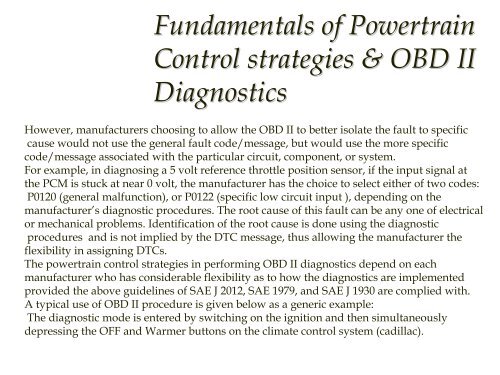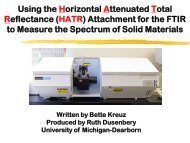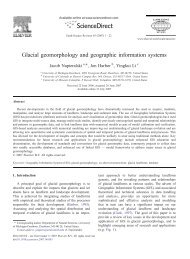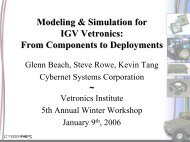Introduction to On Board Diagnostics (II)
Introduction to On Board Diagnostics (II)
Introduction to On Board Diagnostics (II)
Create successful ePaper yourself
Turn your PDF publications into a flip-book with our unique Google optimized e-Paper software.
Fundamentals of PowertrainControl strategies & OBD <strong>II</strong><strong>Diagnostics</strong>However, manufacturers choosing <strong>to</strong> allow the OBD <strong>II</strong> <strong>to</strong> better isolate the fault <strong>to</strong> specificcause would not use the general fault code/message, but would use the more specificcode/message associated with the particular circuit, component, or system.For example, in diagnosing a 5 volt reference throttle position sensor, if the input signal atthe PCM is stuck at near 0 volt, the manufacturer has the choice <strong>to</strong> select either of two codes:P0120 (general malfunction), or P0122 (specific low circuit input ), depending on themanufacturer’s diagnostic procedures. The root cause of this fault can be any one of electricalor mechanical problems. Identification of the root cause is done using the diagnosticprocedures and is not implied by the DTC message, thus allowing the manufacturer theflexibility in assigning DTCs.The powertrain control strategies in performing OBD <strong>II</strong> diagnostics depend on eachmanufacturer who has considerable flexibility as <strong>to</strong> how the diagnostics are implementedprovided the above guidelines of SAE J 2012, SAE 1979, and SAE J 1930 are complied with.A typical use of OBD <strong>II</strong> procedure is given below as a generic example:The diagnostic mode is entered by switching on the ignition and then simultaneouslydepressing the OFF and Warmer but<strong>to</strong>ns on the climate control system (cadillac).
















